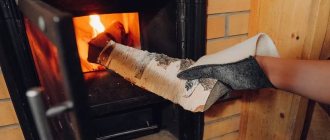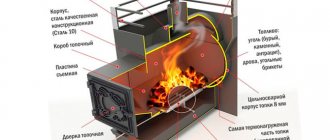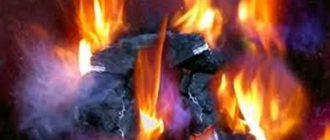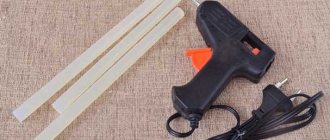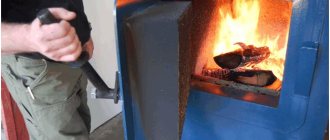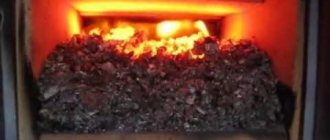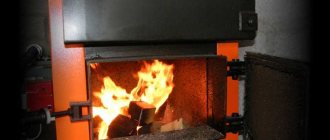Here you will learn:
- Fire wood stoves
- What are fuel briquettes made from?
- Advantages and disadvantages of fuel briquettes
- Popular types of wood briquettes
Despite the widespread construction of gas pipelines, there are still many settlements and places in Russia where there is simply no gas. People have to use alternative heat sources, for example, solid fuel boilers. These units operate on wood, but recently more modern types of fuel have begun to be produced for them - these are fuel briquettes for heating stoves. Let's look at them in more detail and find out their advantages and disadvantages.
In this review we will look at:
- Disadvantages of classic firewood;
- Fuel composition;
- Main types of briquetted fuel;
- Pros and cons of briquettes for the stove.
After reading the review, you will be able to make a choice in favor of traditional firewood or in favor of more modern briquette fuel.
Fire wood stoves
Wood-burning stoves provide efficient heating of residential and non-residential premises. They are presented in many models, differing in their technical characteristics and design. They use the most ordinary firewood as fuel - they can be purchased by the truckload. But this fuel cannot be called modern and efficient. And today it has been replaced by fuel briquettes for heating stoves.
To clarify, let's look at the main disadvantages of traditional wood fuel:
Ordinary firewood must first be chopped and then placed in neat woodpiles. This is a very labor-intensive and time-consuming process.
- It is inconvenient to stack firewood in neat stacks - if they are the same size and format, then this is not so bad. But if some logs are thin, while others are thick, and even knotty, then the masonry will be crooked and oblique (although a lot here depends on the “curvature” of the hands);
- Firewood needs to be split - it often comes in the form of round logs that require chopping. Swinging an ax in cold weather is a dubious pleasure (although useful);
- Firewood is often damp - seeking for their own profit, lumberjacks sell the wood in a raw state, without first drying it. Compared to almost dry fuel briquettes for heating stoves, they will not be easy to light;
- Low calorific value - a cubic meter of firewood produces less heat than the same wood briquettes of the same volume ;
- Firewood produces a large amount of ash - the same wood briquettes practically do not clog the stoves;
- Wood burns with clicking and crackling sounds, burns unevenly, clearly inferior to briquettes in this regard.
Firewood is the most common and cheapest solid fuel for heating stoves and boilers. But fuel briquettes are superior to them due to their convenience and high calorific value.
Price
The price depends on the materials used and the production process. The estimated cost for some types is indicated in the table:
| Types of briquettes | Material | Price for 1 ton (rub.) |
| Pini-kay | from pine needles | 8900 |
| birch | 9500 | |
| RUF | from sawdust | 6500 |
| from ancient flour | 7500 | |
| from pine needles | 6000 | |
| from pine and birch | 6500 | |
| birch | 6900 | |
| Nestro | 7500 | |
| Pellets 6-8 mm light | 8800 | |
| Pellets 8 mm gray | 8000 | |
| Peat briquettes | 7000-9000 | |
| Coal | 8000 | |
| Coal briquettes | 9500 |
What are fuel briquettes made from?
Wood fuel briquettes are made from wood waste - roughly speaking, it is pressed sawdust that has undergone certain preparation. The preparation process includes grinding and drying. As a result, raw materials are born, ready to go under the press. Some sawdust does not need drying at all, since it is almost dry.
Most often, this type of fuel is produced from ordinary sawdust.
Safe organic compounds act as binders in fuel briquettes for heating stoves, and some types of Euro firewood are made without an adhesive base . The harvested raw materials are sent under the press, forming dense, neat bars, ready for further use. Firing can be used as an additional processing - it all depends on the manufacturer and the technologies he uses.
The resulting wood briquettes for heating stoves are sent to consumers - they are suitable for heating houses and non-residential buildings, and are used to light fireplaces. They can also replace firewood for a picnic, but in this case you will not hear the sound of crackling firewood. But you will get an even flame, without flying embers and sparks.
Two important conclusions
1. Different ash content
Two samples of straw briquettes have different ash contents - 4.86 and 7.3%.
Ash is mineral substances in wood that either have little energy value or simply do not burn. Therefore, the more ash in the wood, the less its heat transfer.
Different ash contents of fuel briquettes indicate different quality of production and source materials. One manufacturer does not clean the straw well enough to remove dirt and external ash. Another is adding foliage and other materials for volume. At the output, this greatly affects the quality, calorific value and burning time of the fuel briquette. And this situation can happen with any briquettes, not just straw.
2. Different humidity
The moisture content of the briquettes and their seed husks is 2.7% in one case, and 8.51% in the other. Some sawdust briquettes have a moisture content of 4.1%, while others have a moisture content of 10.3%.
This means that the humidity of fuel briquettes is also different. Their strength and calorific value depend on this: at a humidity of 4.1%, the heat transfer of a briquette is 5043 kcal/kg, and at 10% — 4341 kcal/kg.
Advantages and disadvantages of fuel briquettes
Let's see what good fuel briquettes are for heating stoves, and what are their main pros and cons. Let's start with the positive features:
You are unlikely to have any problems with storing and storing European firewood.
- Ease of storage – thanks to its neat shape, Euro firewood and other briquettes can be stacked in neat, even stacks;
- High calorific value of fuel briquettes - if we compare them with ordinary firewood, they provide one and a half to two times more heat. Due to this, you can save on fuel when firing stoves and boilers;
- Briquettes are a long-burning fuel for any type of stove. Pressed sawdust burns one and a half to two times longer, reducing the number of approaches for adding new portions of fuel . If there is a regular stove in the room that burns with wood for 2-3 hours, then with fuel briquettes this time will increase to 4-5 hours;
- Uniform burning, without unnecessary noise and embers shooting in all directions. In addition, fuel briquettes used to fire stoves emit less smoke and produce less ash, reducing labor costs for cleaning;
- Low formation of resins - this reduces chimney clogging;
- The storage duration of fuel briquettes for heating stoves varies from 1 year to 5 years - it all depends on the manufacturing technology;
- High environmental friendliness - no chemicals are used in the production of briquettes;
- The volume of briquetted fuel consumed during one heating season is 1.5-2 times less than the volume of firewood used during the same time period.
Fuel briquettes intended for heating stoves burn smoothly and softly, releasing a large amount of heat. They do not clog stoves and chimneys and burn almost 99%.
If your home has a long-burning stove or boiler, then you will experience an additional benefit from using briquetted fuel - the combustion duration will increase by another 1.5-2 times, reaching 12-16 hours or more (depending on the model of equipment used).
Unfortunately, it was not without certain disadvantages:
We do not recommend storing briquettes outdoors; they can become damp and spoil.
- Fuel briquettes used to fire stoves are not afraid of dampness. However, they still do not like direct contact with water ;
- Some types of briquetted fuel do not tolerate long-term storage - their shelf life is limited to one year from the date of manufacture;
- The cost of purchasing fuel may be higher than purchasing regular firewood - it all depends on the manufacturer;
- In some regions and localities, purchasing fuel briquettes for heating boilers and stoves is more difficult than buying a truckload of ordinary firewood;
- The cost is slightly higher than the cost of ordinary firewood. But due to the high calorific value and long combustion, you can save a little.
Despite all this, briquetted fuel continues to gain popularity.
Kindling the bath
Eurobriquettes are a universal fuel; they can be used to heat all types of stoves and boilers.
They can be used in outdoor grills and home fireplaces. At the same time, the consumption of fuel briquettes is always significantly less than conventional firewood. Many people are interested in whether it is possible to heat a stove with fuel briquettes if it is made of steel, like an ordinary heater? This question is quite logical, since such stoves have restrictions on the calorific value of the fuel; you cannot heat a steel sauna stove with black coal, which emits 4900 kcal/kg of heat. But in the case of Eurobriquettes, less heat is released, which means they can be used to heat a stove in a bathhouse.
For a bathhouse, not only the heat generated is important, but also the duration of burning of wood or alternative fuel. The longer the wood burns with maximum heat release, the better it is for the sauna stove and the sauna itself.
Lighting fuel briquettes is not very easy, the fire does not catch immediately, but after they light up, they will burn and smolder for a couple of hours, which is much longer than the combustion of ordinary firewood. Such a long combustion time of fuel briquettes is explained by their high density and low humidity.
Let us note that, according to people’s reviews, you should not completely fill the firebox of a sauna stove with Euro-wood, so as not to quickly reach the maximum heat transfer values.
An interesting point with Eurobriquettes is the residues left after their combustion. Having increased density characteristics, this fuel burns almost completely; it does not leave a large amount of ash, only a small pile of ash. Ash from fuel blocks smells unpleasant, but is an excellent fertilizer.
When Eurobriquettes burn, virtually no smoke is emitted, which is very valuable for maintaining the cleanliness of fireboxes, boilers, and chimneys. According to experts, linden fuel briquettes contain the least amount of resin, so when using such fuel, chimneys and boiler nozzles suffer the least.
Fuel briquettes are an excellent option for lighting a black sauna. As we have already said, this fuel is environmentally friendly, does not emit smoke, provides enough heat, and phytoncides appear in the heated air, which have a beneficial effect on the human body and improve immunity. Using the same linden eurobriquettes, you will feel how your body is healing, inhaling the pleasant aromas of flowers, honey and trees.
Of course, there is also a drawback to this type of fuel - it cannot quickly generate a lot of heat, it releases it gradually. As we have already said, the combustion is uniform, which, unlike firewood that flares up quickly and quickly dies out, allows you to easily maintain the same temperature.
Popular types of wood briquettes
We have already talked about the production of fuel briquettes for heating boilers and furnaces, as well as their key advantages and disadvantages. It remains to figure out what types of briquettes are presented on the domestic market.
Fuel briquettes RUF
This fuel resembles white or wood-colored bricks in appearance (the shade varies widely).
RUF briquettes are made from dry sawdust by pressing under high pressure. As a result, Euro-firewood is born, which can be used in any type of stove. Their distinctive feature is the inscription RUF, embossed on both sides. RUF fuel briquettes for heating stoves are characterized by the release of a large amount of heat - they are almost one and a half times more profitable than firewood . They are easy to load combustion chambers and store them in stacks. Pressed bars are not afraid of moisture, but there is also no need to expose them to direct water. This fuel is supplied by many manufacturers - a typical example is. By the way, it also sells many other types of solid fuel.
Eurobriquettes PINI KAY
An interesting feature of these Eurobriquettes is their unusual shape - they resemble square pencils from which someone has taken the lead.
That's why they are called "pencils". In order for it to burn with the release of a large amount of heat, a hole is made in it, increasing the draft. The “pencils” themselves look dark, as they were fired. This procedure makes them more durable and removes excess moisture. The disadvantage of PINI KAY fuel briquettes for heating stoves is that they are more expensive than firewood and even more expensive than any other types of fuel. But they burn well, releasing a large amount of heat. They are also convenient to transport and store. Thanks to their shape, they are ideal for lighting fireplaces. Some people take them with them into the wild to use PINI KAY bars instead of wood for a fire.
Simple cylindrical briquettes
The simplest fuel briquettes for heating stoves are also on sale - in the form of cylinders. They are made from pressed sawdust and small wood waste. All this is pressed under slight pressure using a non-toxic adhesive base, after which the finished bars are sent to consumers. This fuel is cheap, but has one distinct drawback - low strength. It easily disintegrates and crumbles and does not withstand exposure to moisture.
Fuel briquettes from coal and peat
Peat and coal fuel briquettes for heating stoves are made from peat and coal, respectively. The starting materials are formed into small cylinders. The fuel can be used to light stoves and solid fuel boilers. Coal products give a high combustion temperature, but are characterized by high ash content .
As for peat fuel, it is ideally suited for long-burning stoves, but it also produces a lot of ash. If you have a stove that needs something to heat, we recommend that you use PINI KAY or RUF fuel briquettes. They are distinguished by their convenience and high calorific value, form a minimum of ash and provide long-lasting combustion.
House heating
Fuel briquettes are probably ideal for heating a home. The ability to light the stove once and maintain the fire and heat for a long time without additional tossing allows us to talk about the good characteristics of Eurobriquettes. Let's look at how to heat a brick stove with fuel briquettes within the house.
What is better to choose regular firewood or “euro”?
The main problem associated with biomass gasification as an electricity generation technology is the purification of the gas resulting from the process of impurities that accompany it. Gasification has a number of advantages. The resulting gas is more versatile and can be used for the same purposes as natural gas.
It can be burned to produce heat and steam and can drive internal combustion engines and gas turbines to generate electricity. These processes use the biochemical characteristics of biomass and the metabolic action of microbial organisms to produce gaseous and liquid fuels. They are more suitable for wet biomass conversion than thermochemical processes.
Of course, pressed bricks will not burn immediately, so let’s figure out how to light fuel briquettes. This is quite simple to do; first of all, you should put tree bark, wood chips, and some dry newspapers in the oven, and then place alternative firewood on top. During kindling, while the wood chips are actively igniting, we adjust the airflow. As soon as the fire starts on the first briquettes, you can add the rest.
Digestion of biomass soaked by bacteria in an oxygen-free environment creates a flammable gas called biogas. In this case, the biomass is placed in a closed container and allowed to ferment; After a few days, depending on the ambient temperature, there will be a gas that is a mixture of methane and carbon dioxide. The remaining material in the digester is a good organic fertilizer. In China and India, digests were intensively promoted for domestic use when replacing firewood.
So which is better?
Black water and honey can also be used as raw materials, which also serve to purify water. Biomass can produce liquid fuels such as ethanol and methanol. The first is produced by fermentation of sugars, and the second by destructive distillation of wood. The technology has been used for centuries to produce alcoholic beverages and, more recently, to replace fossil fuel substitutes for transportation. These fuels can be used in pure form or mixed with others, for transportation or for driving cars.
Another option is to heat the stove with fuel briquettes after the first batch of wood has burned and decent coals have appeared. In such a firebox, the fire can quickly be caught on Eurobriquettes.
Methodology for calculating the amount of fuel for the season
Let's figure out how to calculate the consumption of any type of fuel for a room. First, we will calculate how much heat is needed to heat the entire house per hour. Multiplying by 24, we get the daily value, then multiplying by 30 and 111 days, what is the consumption per month and for the entire heating period.
After this, we calculate the heat transfer of the accepted unit of measurement for each type of solid fuel. By dividing the amount of heat required per month and season by heat transfer, we will see how much of this type of combustible material is needed per month and for the whole year. This will show us how much fuel we need to store for the winter and allow us to compare the efficiency of different devices.
What should you not light the stove with?
You can't drown
wood
stove
with coal, coke.
Open fireplaces can only be heated with dry, non-resinous (birch, aspen) logs no longer than 2/3 of the depth of the combustion chamber. cannot be lit
with coniferous wood (without an enclosing mesh), since when the wood resin boils, coals are thrown out of the fireplace.
Interesting materials:
How is ammonia useful? What are the benefits of parsley infusion? How is a robot vacuum cleaner useful? What are the benefits of plums? What are the benefits of broccoli for women? How is wood ash useful in the garden? How is phacelia useful? What are the benefits of Magnolia? What are the benefits of egg shells? What are the benefits of fresh nettle?
General information
Fuel briquettes, or Eurofirewood as they are also called, are made from pressed natural materials, most often sawdust, sometimes peat or straw, rarely from seeds or nut shells. During the pressing process, most of the moisture is removed from the wood, which makes it possible to obtain high calorific characteristics. Unlike firewood, whose maximum dryness is determined by 20% humidity, the same parameter for fuel briquettes is 8-9%.
The design of briquettes can be different:
- Eurobriquettes RUF - made exclusively by pressing without additional processing.
- Nestro Eurobriquettes are compressed logs that have a cylindrical shape, sometimes with a hole in the middle.
- Eurobriquettes Pini-Kay are compressed sawdust fired with a gas-air mixture to create a more durable shape, which increases storage time and protection from moisture.
Regardless of the type of fuel briquettes, their density is higher than wood, which allows them to burn well and release a large amount of heat. Thermal characteristics differ for Eurobriquettes made from different materials; usually high-quality types of wood, cereal seed husks, straw, and peat are used.
In the production of all types of eurobriquettes, no adhesive additives are used, since wood and similar materials contain a suitable lignin component that can glue all the sawdust together.
Due to the fact that fuel briquettes are made from drier wood, their calorific value is significantly greater than that of ordinary firewood or brown coal and is remotely comparable to the characteristics of black coal. For example, dry birch firewood emits 2500 kcal/kg when burned, brown coal about 3800 kcal/kg, and fuel briquettes 4500 kcal/kg. Thus, for heating premises, the option with such fuel is quite acceptable, but are fuel briquettes suitable for a bathhouse, is it possible to heat a stove in it using this fuel.

